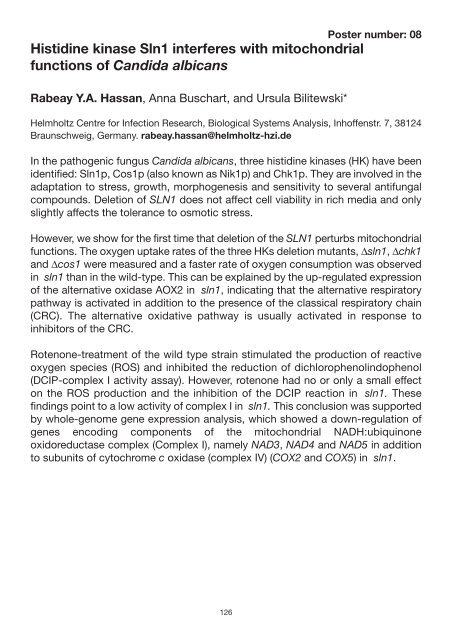Candida Infection Biology – fungal armoury, battlefields ... - FINSysB
Candida Infection Biology – fungal armoury, battlefields ... - FINSysB
Candida Infection Biology – fungal armoury, battlefields ... - FINSysB
You also want an ePaper? Increase the reach of your titles
YUMPU automatically turns print PDFs into web optimized ePapers that Google loves.
Poster number: 08<br />
Histidine kinase Sln1 interferes with mitochondrial<br />
functions of <strong>Candida</strong> albicans<br />
Rabeay Y.A. Hassan, Anna Buschart, and Ursula Bilitewski*<br />
Helmholtz Centre for <strong>Infection</strong> Research, Biological Systems Analysis, Inhoffenstr. 7, 38124<br />
Braunschweig, Germany. rabeay.hassan@helmholtz-hzi.de<br />
In the pathogenic fungus <strong>Candida</strong> albicans, three histidine kinases (HK) have been<br />
identified: Sln1p, Cos1p (also known as Nik1p) and Chk1p. They are involved in the<br />
adaptation to stress, growth, morphogenesis and sensitivity to several anti<strong>fungal</strong><br />
compounds. Deletion of SLN1 does not affect cell viability in rich media and only<br />
slightly affects the tolerance to osmotic stress.<br />
However, we show for the first time that deletion of the SLN1 perturbs mitochondrial<br />
functions. The oxygen uptake rates of the three HKs deletion mutants, ∆sln1, ∆chk1<br />
and ∆cos1 were measured and a faster rate of oxygen consumption was observed<br />
in sln1 than in the wild-type. This can be explained by the up-regulated expression<br />
of the alternative oxidase AOX2 in sln1, indicating that the alternative respiratory<br />
pathway is activated in addition to the presence of the classical respiratory chain<br />
(CRC). The alternative oxidative pathway is usually activated in response to<br />
inhibitors of the CRC.<br />
Rotenone-treatment of the wild type strain stimulated the production of reactive<br />
oxygen species (ROS) and inhibited the reduction of dichlorophenolindophenol<br />
(DCIP-complex I activity assay). However, rotenone had no or only a small effect<br />
on the ROS production and the inhibition of the DCIP reaction in sln1. These<br />
findings point to a low activity of complex I in sln1. This conclusion was supported<br />
by whole-genome gene expression analysis, which showed a down-regulation of<br />
genes encoding components of the mitochondrial NADH:ubiquinone<br />
oxidoreductase complex (Complex I), namely NAD3, NAD4 and NAD5 in addition<br />
to subunits of cytochrome c oxidase (complex IV) (COX2 and COX5) in sln1.<br />
126


